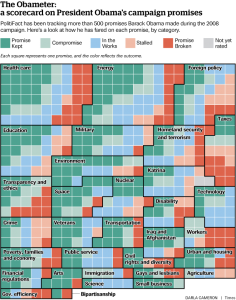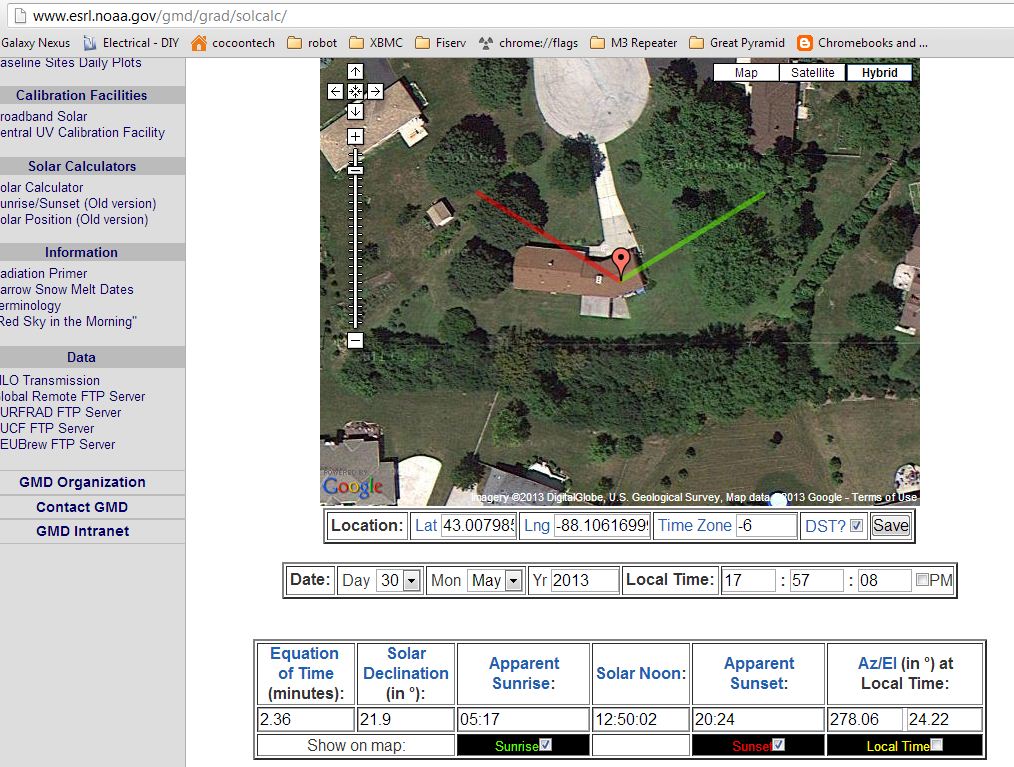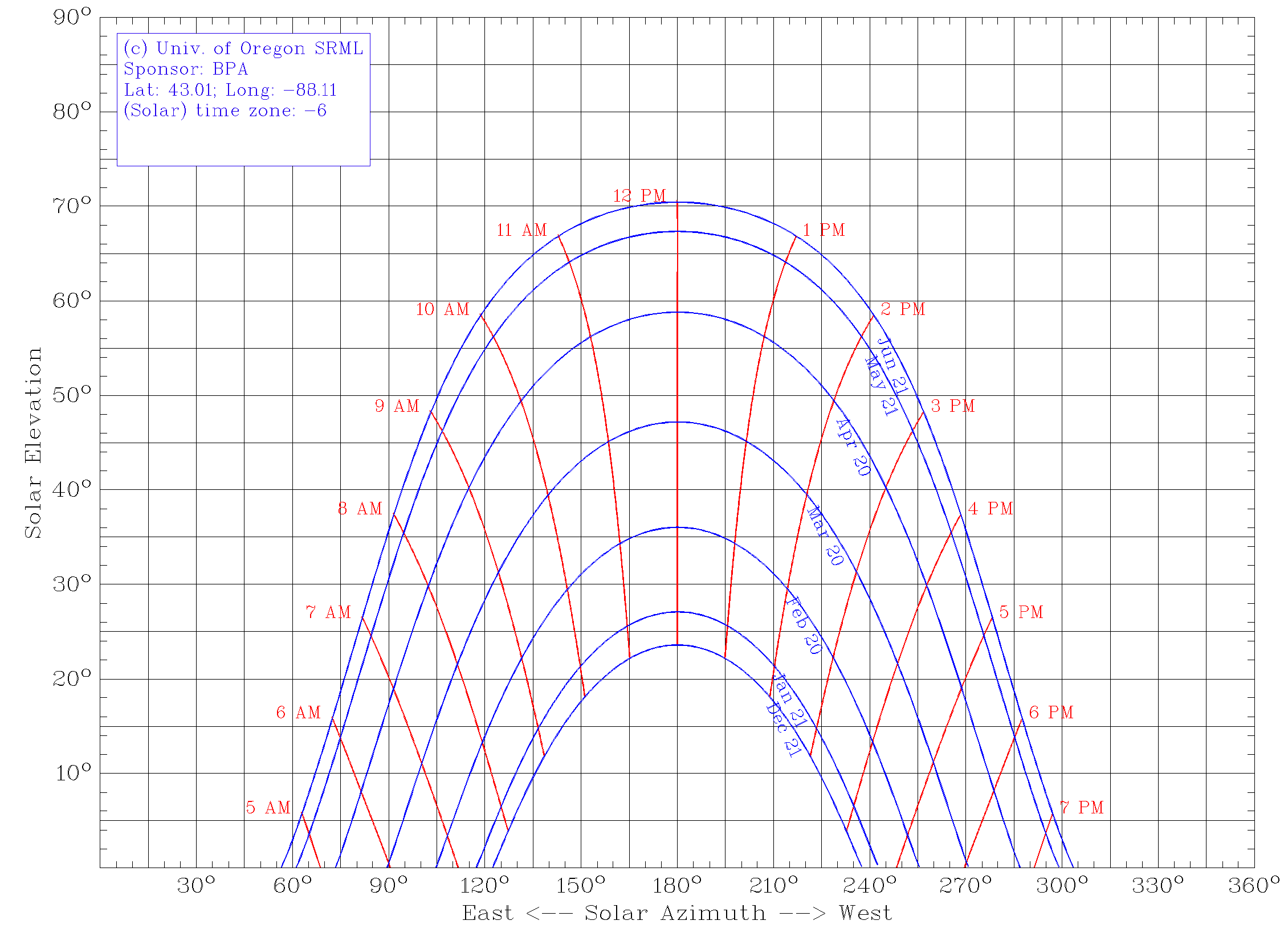Another metric used to determine a President’s right to a second term is the analysis of campaign promises made vs. campaign promises kept. This is a difficult metric to gauge since many factors affect one’s  ability to deliver on promises. Remember that a sitting president, after all is said and done, can only actually do the following: he can make war , veto legislation, and issue Presidential directives (which by definition must not have the same impact as law).
ability to deliver on promises. Remember that a sitting president, after all is said and done, can only actually do the following: he can make war , veto legislation, and issue Presidential directives (which by definition must not have the same impact as law).
Here then, are the results from two different sources. First we have PolitiFact.org. Click on the image to the left for a full size version showing their tracking of more than 500 campaign promises. What’s nice about this chart is they way they colored everything. Green is “promise kept”, light green is “compromise”, light blue is “in the works”, light red is “stalled” and red is “promise broken” Assimilation of the compiled results then becomes a bit more of a visual exercise. How does it look to you?
Next, we have Al Jazeera’s take on some of the major campaign promises that Obama made in 2008, how he has done on them, and what the contributing issues were that surrounded their status. This is an good read from an outside source that in my opinion paints an interesting picture of how the rest of the world might just be viewing our President’s promise legacy.
Source: Al Jazeera
Publication date: October 1, 2012
By the Al Jazeera staff
Economy
Repeal Bush-era tax cuts for high-income earners
During the 2008 campaign, a cornerstone of Obama’s proposed economic plan was to allow tax cuts for those who earn more than $250,000 annually, put in place during George W Bush’s presidency, to expire. The increased government revenues would be used to fund expanded government spending programmes for low-income Americans.
At the end of 2010, however, Obama brokered a major compromise on taxes, agreeing to renew the Bush-era cuts for another two years, in return for a one-year reduction in Social Security taxes and an additional year of unemployment benefits for certain workers, both also promises he made during his campaign.
The tax cuts are now due to expire in December 2012, and Obama has made repealing them a campaign issue once more. Whether or not he’ll be any more successful in his second term remains to be seen.
Increased financial regulation as part of a fiscal stimulus package
In 2008, as then President Bush put into place the Troubled Asset Relief Programme (TARP) to rescue several financial institutions – including Citigroup, AIG, Bank of America and others – Obama promised that he would put into place widespread changes to US financial regulation, making all major financial institutions subject to greater government oversight.
In July 2010, President Obama signed the Dodd-Frank Wall Street Reform and Consumer Protection Act, putting into place the most widespread changes to financial regulation in the United States since the 1930s Great Depression. The Act institutes new rules on mortgage eligibility, gives the federal government the authority to regulate derivatives trading, and institutes greater oversight over hedge funds.
It also creates a new Consumer Financial Protection Bureau and restricts banks’ ability to use customers’ funds in investments.
Critics of Dodd-Frank, however, say that with intense pressure from both Republicans and Wall Street to limit government intrusion in financial market practices, the Act has not had the practical impact that it should have. Others argue that it does not go far enough, and institutionalises the idea of government bailouts for firms that are ‘too big to fail’.
Defense and Security Policy
Revamp US military strategy in Afghanistan
Obama ordered a comprehensive review of the US military strategy in Afghanistan as soon as he entered office. As a result of the review, he ordered an immediate 30,000 troop surge, with a built-in withdrawal beginning in July 2011. Moreover, US troops would move towards a greater training role, helping an expanded Afghan National Army and local police to secure the country on their own. A full US withdrawal date of 2014 was set.
Obama has been largely successful in making this happen, although questions remain about the effectiveness of the new strategy, heavily focused as it is the counter insurgency (COIN) principle used in Iraq. Foreign casualties soared in by 36 per cent in 2010 as military engagement increased, but began to drop again in 2011 and 2012. Major questions remain about security, however, as the Taliban and Haqqani Network have successfully implemented attacks on major US bases and international targets in the intervening period.
Complete withdrawal of US troops from Iraq on schedule
Obama promised to have all combat troops withdrawn from Iraq within about 16 months of taking office. In August 2010, the final US combat brigade left the country, leaving behind about 50,000 soldiers who were engaged primarily in training and security operations. Those troops, too, left the country a few days ahead of the December 2011 deadline set under the final US-Iraq agreement on troop presence. Security in Iraq is now entirely in the hands of the Iraqi government, with all major US wartime bases closed and remaining troops involved only in diplomatic security or limited training missions. Private security contractors, however, do continue to operate in Iraq.
Close detention facility at Guantanamo Bay
As a candidate for the presidency, Obama unequivocally stated that he would close the US military detention facility at Guantanamo Bay in Cuba. Within two days of taking office in January 2009, he promised to close it within a year.
On March 7, 2011, however, he signed an executive order that made a number of changes to policies regarding those detained at the facility that, among other things, resumed the holding of military trials for detainees. The new policies also established a new process of ‘periodic review’ for captives who were being held without charge, on the justification that they remained ‘at war with the United States’, according to the White House.
The order was widely seen as an admission that the White House had failed in its pledge to close the facility.
End the use of torture by US interrogators in the ‘War on Terror’
In the statement made regarding Guantanamo Bay in January 2009, Obama also addressed the issue of the use of torture by US interrogators (or foreign interrogators on the behalf of the United States). The order stated that prisoners would ‘in all circumstances be treated humanely and shall not be subjected to violence to life and person (including murder of all kinds, mutilation, cruel treatment, and torture), nor to outrages upon personal dignity (including humiliating and degrading treatment)’. It also specifically nullified certain interpretations on federal law regarding interrogations issued under former President Bush.
The American Civil Liberties Union (ACLU) and Human Rights Watch both endorse the view that torture is no longer US policy and does not occur in the systematic and officially endorsed manner that it had since 2001.
Obama has received criticism, however, for his administration’s policy of not aggressively investigating allegations of torture committed before he assumed the presidency. In August 2012, the US Justice Department officially closed the only remaining investigations into torture allegations, without charging any suspects.
In other civil liberties related promises, Obama also pledged to introduce greater oversight on several aspects of the Patriot Act under former President Bush, including warrantless wiretaps. Obama has twice reauthorised several provisions of the Act, including those allowing for such surveillance. Some additional oversight has been enacted, but the Act remains, by and large, unchanged since Obama assumed office.
Changing Washington
Ending partisan politics and ushering a new era of across-the-aisle co-operation
A key part of Obama’s campaign was his promise to bring change to the way that politics was practiced in Washington DC, uniting Democrats and Republicans to work for their constituents, rather than getting bogged down in partisan bickering.
In 2011, the US Congress set new records for partisan voting, according to data from the Congressional Quarterly. The House of Representatives, with a Republican majority body since 2010, set a new record for the number of votes where majorities from each party voted against each other. The Senate, where Democrats are in the majority, was not quite as polarised, but the average Senator for Obama’s Democratic party voted along party lines far more than at any time in the last five decades.
Moreover, by September 2012, the current Congress had passed only 61 bills into law, putting it on course (if it maintains its current pace) to be the least productive legislature since 1947.
While it takes two to tango – and Republicans had pledged on retaking the majority in the House to adopt a policy of non-co-operation with Obama – this still rates as a promise Obama failed to fulfill.
Legislative reform involving ethics and lobbying
During his campaign, Obama promised to create a central database that would provide ‘lobbying reports, ethics records and campaign finance filings in a searchable, sortable and downloadable format’. He also promised to enforce tougher rules restricting officials from taking up lobbying positions and vice versa.
Three years in, in March 2012, the White House launched ethics.gov, which provides exactly that, in addition to White House visitor records and FEC filings. The Obama administration did not, however, make its email and phone records public, as Obama had promised to do as part of an effort to provide greater transparency on lobbyists’ access to the White House.
The promise to curtail the so-called ‘revolving door’ between official and lobbyist positions has been described as the cornerstone of Obama’s lobbying reform project, and on this the administration has failed. Obama signed an executive order saying that former lobbyists would not be allowed to work in an official capacity on subjects related to their lobbying work for a period of two years since they gave up those positions. The administration has, however, granted number of waivers and recusals on this front, meaning that the promise has never entirely been kept.
Social/Other Policies
Introduce broad-ranging immigration reform
During his campaign, Obama promised to introduce broad-ranging immigration reform within his first year in office, including (but not limited to) providing undocumented immigrants with a path to citizenship, securing the border and legally punishing employers who hire undocumented workers.
In 2011, Obama introduced the Development, Relief and Education for Alien Minors (DREAM) Act, aimed at allowing a path to citizenship for illegal immigrants who entered the US as minors, as long they had either completed their education there or served in the US military. The Act was voted down by a Republican-majority lower house in 2010.
His administration has made progress by adopting the Deferred Action for Childhood Arrivals (DACA) policy, which adopts some of the same processes as stipulated in the DREAM Act, but the change is far from comprehensive.
During his 2012 campaign, Obama has stressed that the DREAM Act remains a legislative priority.
Introduce a ‘universal’ health care system in the US
As a candidate, Obama promised that he would sign a ‘universal’ health care bill into law by the end of his first term as president. His complex proposal for wide-ranging health care reform promised to cut health care costs for families, while ensuring that no US citizens were left outside of health care insurance coverage (unless they did so by choice).
In March 2010, Obama signed the Patient Protection and Affordable Care Act (often dubbed ‘Obamacare’ by its critics). The act does indeed ensure that all citizens have health care coverage through insurance providers – either by paying their own premiums, or through government programmes for those who are not able to afford premiums. It also ensures the insurance companies can no longer refuse to cover those with pre-existing medical conditions.
Obama also promised, however, to cut the premiums of a typical US family by up to $2,500 annually as part of his health care reform. While the full economic effect of the law is difficult to gauge, since the act is a complex piece of legislation that allows for those below the poverty line to receive government support in paying premiums, while increasing the bills of others, analysts say that it is unlikely that the ‘typical’ family’s premiums will fall by as much as $2,500 – indeed, many say that costs will rise for those who can afford them.
The Act also reforms Medicare, a government programme that provides health care insurance support for seniors, as per Obama’s campaign promises regarding existing holes in coverage and flaws in accessibility.
Repeal military’s Don’t Ask Don’t Tell policy on homosexual members
As a candidate, President Obama pledged to repeal the US military’s official policy on the sexual orientation of its members. The existing policy stated that gays and lesbians were free to serve in the military as long as they did not openly declare their sexual orientation, and allowed for them to be removed from service if they did so.
In December 2010, Obama signed a bill into law repealing the policy, and, after a nine-month transition and implementation period, ‘Don’t Ask, Don’t Tell’ officially expired on September 20, 2011.
Support the repeal of the Defence of Marriage Act
In 2008, Obama pledged to repeal the Defence of Marriage Act, which states that marriage in the United States can only legally occur between a man and a woman. He said he would replace the 1996 legislation with a law that would provide equal rights to same-sex couples.
As president, while he has taken steps to replace it – the Justice Department said in 2011 that it would stop defending the law in court as it considered it unconstitutional – any further progress on repealing the law or replacing it has stalled.
In May 2012, Obama stated in an interview that he supported the right of gay and lesbian couples to wed. At present, a new bill on the subject, supported publically by Obama, is present before the Senate, but there has been no debate on it in almost a year.
Reduce US domestic oil consumption by 35 per cent by 2030
Obama pledged to reduce oil consumption in the United States by 35 per cent by 2030 by having industries and consumers switch to renewable forms of energy.
While it is almost impossible to say if the US will hit Obama’s target 18 years from now, he has started several initiatives aimed at making the 35 per cent cut a reality. In particular, he has put in place a plan to phase out $300 billion in fossil fuel subsidies internationally, increased a mandate that requires gasoline to be blended with other forms of more environmentally friendly carbon fuels, and provided several incentives to the renewable energy industry.
Also on the environment front, Obama pledged to introduce a cap-and-trade bill to reduce air pollution, using the proceeds to fund the creation of five million new ‘green’ jobs. While the bill stalled in Congress, the Obama administration has frequently pushed for investments in the environment sector (the economic stimulus plan, for example, provides more than $90 billion in grants, tax cuts and other incentives to firms in the sector).
 Just zoom the satellite image to your proposed site and drop the large pin on the exact location. Voila, solar noon is displayed! There’s other cool stuff you can display too such as the sunrise and sunset angles. These are the red and green lines shown on my image above. What you want to do with these is to first change the date to display for the summer solstice then note the obstructions. In my case, you can see the two maple trees to the left and right of the house along with the woods behind me are potential shading factors.
Just zoom the satellite image to your proposed site and drop the large pin on the exact location. Voila, solar noon is displayed! There’s other cool stuff you can display too such as the sunrise and sunset angles. These are the red and green lines shown on my image above. What you want to do with these is to first change the date to display for the summer solstice then note the obstructions. In my case, you can see the two maple trees to the left and right of the house along with the woods behind me are potential shading factors.


















